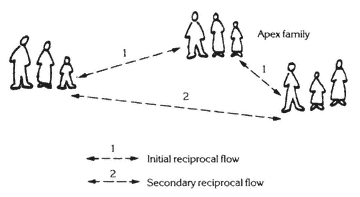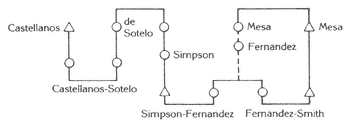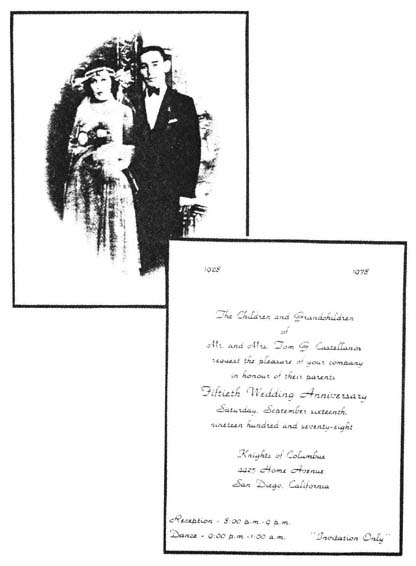Los Simpson
The ties of los Simpson with other frontera settlers began in the cape pueblo of San Antonio and developed through the family's migration north. In San Antonio los Simpson knew the family of Loreto Marquez (to whom, descendants state, they were distantly related) before los Marquez went north to Las Flores around 1890.[3] The Simpsons also went on the mining circuit, where they met and united with other families that became part of the network. In Calmallí they met los Castellanos, Sotelo, Smith, Bolume, and others. Los Simpson eventually went to San Fernando, then crossed the border at Campo and headed east to Calexico.

Diagram 11.
Initial reciprocity
The Simpsons' assistance to families entering the frontera shows the mutual aid and kinlike support they extended to other mining families. In Calexico they offered their home and assistance to the family of Don Pancho Sotelo until the new arrivals found work in Mexicali and moved across the border. In the same period Narcisso Castellanos, his wife Cleofas, and their children stayed with Guillermo and Artemicia Simpson until they too found work. The mutual friendships of the mining circuit experience were further enhanced not solely by the assistance and support offered by the Simpsons but also through the social sentiment and solidarity of mutual friendship between these families.
In a pattern now familiar the Simpsons left Calexico, traveled west, and settled in San Diego. There, once again, they received Pancho Sotelo and his family, who had left Calexico and now sought help in settling in San Diego. The Sotelos remained in the Simpson household until Don Pancho got a job and moved to Lemon Grove.
The kin linkages of the Simpsons are also illustrative of their apex role in the tight web of interrelations among the Baja Californio population. Los Sotelo speak about their kin relation to los Simpson. Descendants speak of this as a distant tie that became significant after migration. Confianza and friendships derived from the migration experience appear to be the important link that established close ties between the two families. Los Sotelo are related to los Simpson through Señora Artemicia Simpson (whom Guillermo met and wed in San Ignacio). Don Francisco's wife Angelina was Sra. Artemicia's maternal

Diagram 12.
The kin ties of los Simpson and los Sotelo
aunt. These links were further strengthened among second-generation frontera offspring. The close friendships of the Sotelos and Castellanos provided a base for the marriage between offspring of these families. Refugio Sotelo and Tiburcio Castellanos were wed in San Diego, and when Guillermo Simpson's son (Guillermo II) married and had children, los Castellanos served as padrinos de bautismo (baptismal godparents), forming a compadrazgo relationship between these families. The linkage does not stop here. Guillermo Simpson (II) married Sarah Fernandez, whose family had come north from Santa Rosalía during

Diagram 13.
The compadrazgo relationship between los Castellanos-Sotelo
and los Simpson
the mining circuit period. This link united another network of families that had become acquainted on the mining circuit but had not become formally linked. Sarah Fernandez's sister Flora married Manuel Smith II, son of Apolonia Mesa and Manuel Smith from Comondú. Furthermore, the Fernandez family can be traced directly to the Mesas of Comondú, who are direct descendants of Apolonia Mesa-Smith.
The compadrazgo relationships between the Simpsons and the Castellanos-Sotelos, along with the marriage of Guillermo Simpson to Flora Fernandez, brought two extended families together into a web of relations. This network was further cemented by a series of compadraz -

Diagram 14.
The Simpson linkage to Castellanos-Sotelo and Fernandez-Smith
gos and marriages. The most obvious and important is the second marriage of Don Francisco Sotelo himself. Don Francisco married Sarah Fernandez de Simpson's maternal aunt (Refugio) in the late 1920s (see diagram 15).
This complicated set of linkages illustrates the multiple sets of interfamily relations in Calexico and San Diego during the 1920s. This example is only a skeletal outline of the matrix of interpersonal relations between kin and nonkin in the frontera region which produced social fields among these families. The Simpsons, like other apex families, provided key links in marriages and compadrazgos which helped form a tight social community in San Diego during the 1930s.
Apex families and individuals play a role similar to that of centralizing women (see the history of the Gomez family in Lomnitz 1978). Like centralizing women, apex families provided emotional centrality and leadership for a variety of network members. This emotional sharing was based primarily on mutual experiences, confianza, parentesco, and the recognition of a similar sociocultural standing (class). This sentiment was further emphasized in the mutual aid and reciprocity of relations and extension of kinship between network members. Unlike the patron-client relationships discussed by Lomnitz, the role of apex families remains at the level of mutual aid; there are no "big men" of upper class and better economic standing who, because of class standing, become apex individuals. During frontera era settlement in San Diego, the network was a homogeneous class composed of laborers and small entrepreneurs. Indeed, economic aid and reciprocity was an important component of network development, but shared experiences, kin ties, and acquaintances that fostered parentesco and the mutual responsibility such sentiment requires were of prime importance. Apex families, like apex individuals, are also differentiated from

Family Invitation to Fiftieth Wedding Anniversary of Refugio Sotelo and
Tiburcio Castellanos
centralizing personalities because they aid in the formation of key kin linkages between a variety of families. The Simpsons clearly illustrate such linkages through various generations and members of their family.